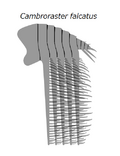Biology:Cambroraster
| Cambroraster | |
|---|---|

| |
| Fossil of a Cambroraster head sclerite (ROMIP 65079) | |
| File:Video animation of Cambroraster.webm | |
| Video animation | |
| Scientific classification | |
| Domain: | Eukaryota |
| Kingdom: | Animalia |
| Phylum: | Arthropoda |
| Class: | †Dinocaridida |
| Order: | †Radiodonta |
| Family: | †Hurdiidae |
| Genus: | †Cambroraster Moysiuk & Caron, 2019 |
| Type species | |
| Cambroraster falcatus Moysiuk & Caron, 2019
| |
| Species | |
| |
Cambroraster is an extinct monotypic genus of hurdiid radiodont, dating to the middle Cambrian, and represented by the single formally described species Cambroraster falcatus.[1] Hundreds of specimens were found in the Burgess Shale, and described in 2019.[2] A large animal (for its era) at up to 30 centimetres (12 in) (but not as long as Titanokorys at 50 centimetres (20 in)), it is characterized by a significantly enlarged horseshoe-shaped dorsal carapace (H-element), and presumably fed by sifting through the sediment with its well-developed tooth plates (oral cone) and short frontal appendages with hooked spines.[1] Nicknamed the "spaceship" fossil when first found, for the way its dorsal carapace resembles the fictional Millennium Falcon, the specific epithet falcatus in its scientific name is a nod to that resemblance.[1][3][4]
A second species of Cambroraster is known from the Chengjiang Biota of South China, making it the first uncontroversial hurdiid from the Cambrian of China. This species is known only from a juvenile dorsal carapace, so it was not given a specific name.[5]
Although originally suggested to have used its frontal appendages to sift sediment for prey, a later study by different authors suggested that it may have been a filter feeder instead.[6]
See also
- Paleobiota of the Burgess Shale
- List of Chengjiang Biota species by phylum
References
- ↑ Jump up to: 1.0 1.1 1.2 Moysiuk, J.; Caron, J.-B. (31 July 2019). "A new hurdiid radiodont from the Burgess Shale evinces the exploitation of Cambrian infaunal food sources". Proceedings of the Royal Society B: Biological Sciences 286 (1908): 20191079. doi:10.1098/rspb.2019.1079. PMID 31362637.
- ↑ Wu, Katherine J. (30 July 2019). "Meet Cambroraster falcatus, the sediment-sifting 'Roomba' of the Cambrian". Nova. https://www.pbs.org/wgbh/nova/article/cambroraster-falcatus-cambrian.
- ↑ "A voracious Cambrian predator, Cambroraster, is a new species from the Burgess Shale". Royal Ontario Museum. 30 July 2019. https://phys.org/news/2019-07-voracious-cambrian-predator-cambroraster-species.html.
- ↑ "Scientists name new fossil species after Millennium Falcon from Star Wars". 3 August 2019. https://arstechnica.com/science/2019/08/scientists-name-new-fossil-species-after-millennium-falcon-from-star-wars/.
- ↑ Liu, Yu; Lerosey-Aubril, Rudy; Audo, Denis; Zhai, Dayou; Mai, Huijuan; Ortega-Hernández, Javier (2020). "Occurrence of the eudemersal radiodont Cambroraster in the early Cambrian Chengjiang Lagerstätte and the diversity of hurdiid ecomorphotypes" (in en). Geological Magazine 157 (7): 1200–1206. doi:10.1017/S0016756820000187. ISSN 0016-7568. Bibcode: 2020GeoM..157.1200L.
- ↑ De Vivo, Giacinto; Lautenschlager, Stephan; Vinther, Jakob (2021-07-28). "Three-dimensional modelling, disparity and ecology of the first Cambrian apex predators" (in en). Proceedings of the Royal Society B: Biological Sciences 288 (1955): 20211176. doi:10.1098/rspb.2021.1176. ISSN 0962-8452. PMID 34284622.
Wikidata ☰ Q66108229 entry
 |






